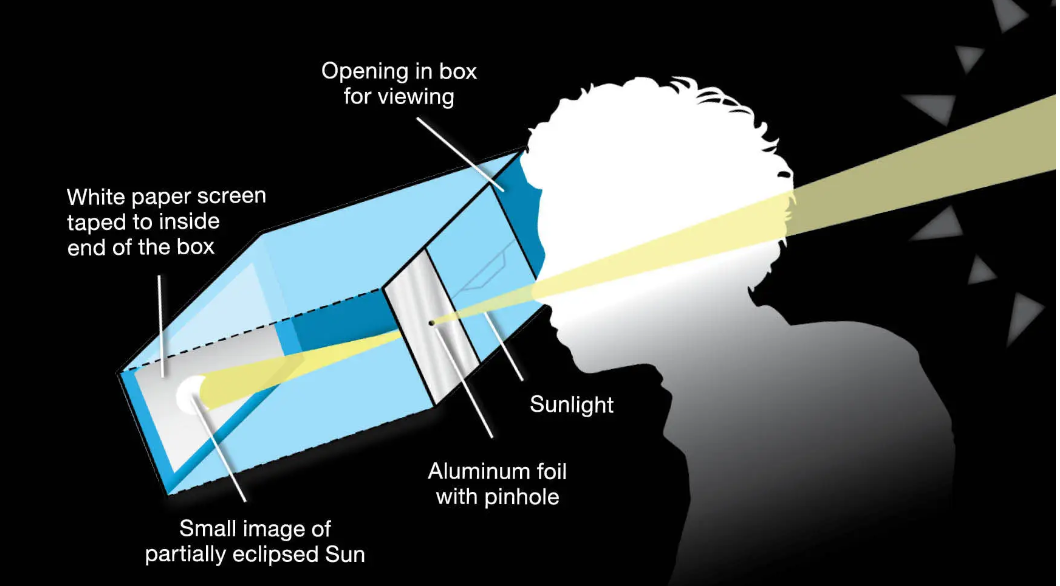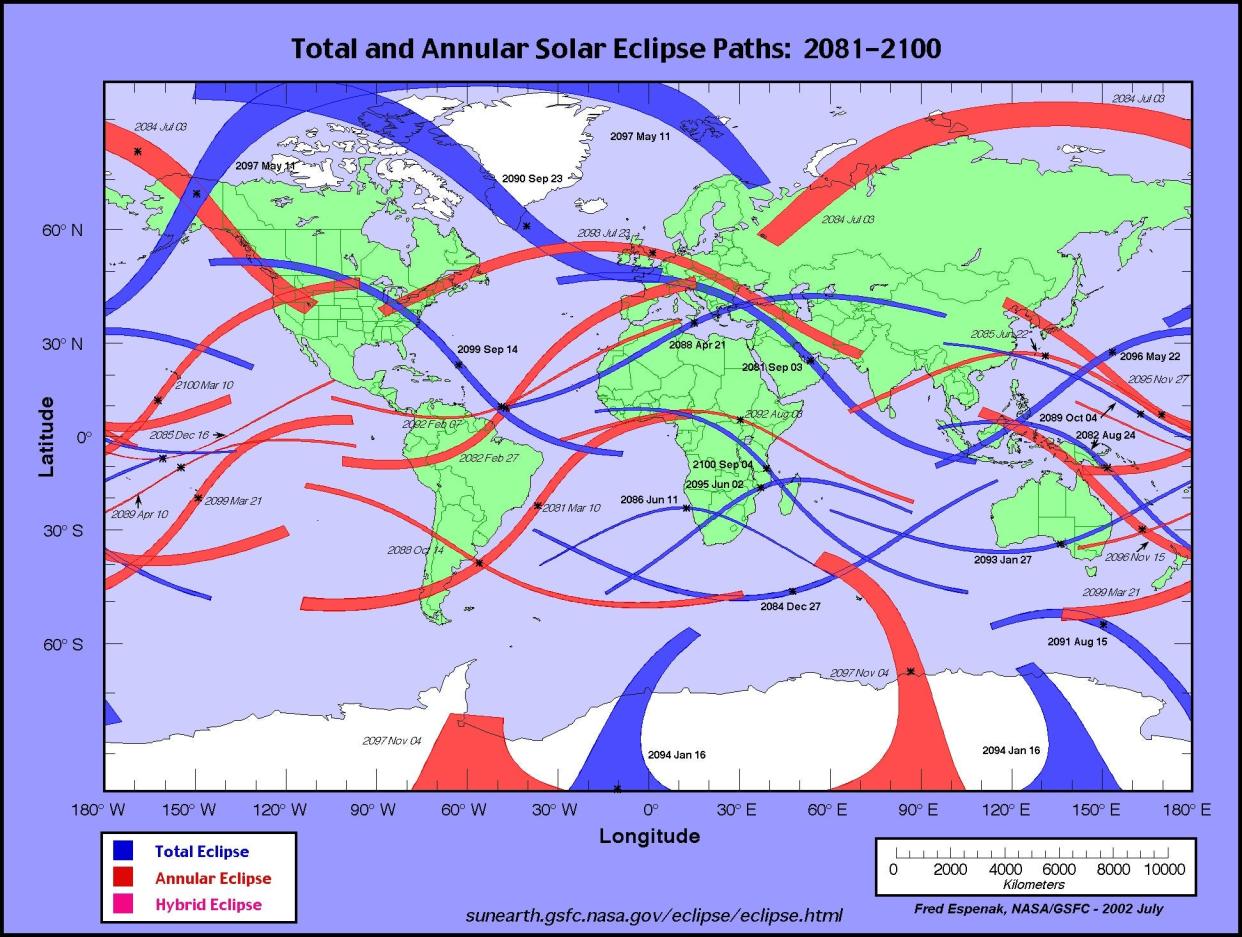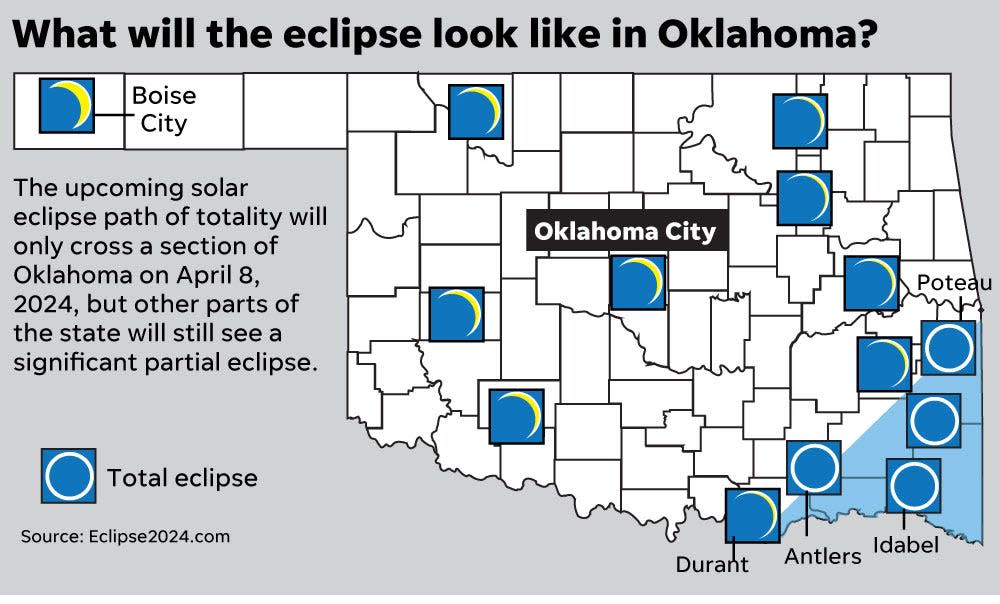The 2024 solar eclipse is next week! Here's everything you need to know
In just a few days, the April 8 solar eclipse will cross a wide swatch of the United States, with an expected 34 million Americans witnessing the celestial show.
The 2024 solar eclipse will last longer than the one viewed by more than 20 million people in August 2017, and according to NASA won’t happen again for another 20 years. Fifteen total solar eclipses have been recorded in the U.S. in the last 150 years, with the next one expected in August 2044.
Parts of southeastern Oklahoma will experience totality, and other parts of the state will see a partial eclipse.
You will need special eclipse glasses to be able to take in the experience so you don't risk eye damage. Thankfully, there is still time to get your hands on a pair — or create your own eclipse viewer at home.
Here's everything to know about the April 8, 2024, solar eclipse.
What is a solar eclipse?
Solar eclipses occur when the moon passes directly between the sun and Earth’s orbits, creating an eclipse of Earth’s view of the sun. The term "eclipse" traces its roots to the Latin “eclipsis,” drawn from the Greek “ekleipsis.”
The path of totality is the predicted path of the eclipse; in this case, from Mexico, through the U.S. across Texas and North America to the coast of Newfoundland, Canada. States in the path of totality for the 2024 solar eclipse include Texas, Oklahoma, Arkansas, Missouri, Illinois, Kentucky, Indiana, Michigan, Ohio, Pennsylvania, New York, Vermont, New Hampshire and Maine.
What is the 2024 solar eclipse path?
Use the map below to see NASA's prediction of the April 8 solar eclipse's path of totality. Keep in mind that this is a prediction, and predictions can vary, but they may only affect you if you're on the very edge of the path.
What time will the 2024 eclipse be in Oklahoma?
The eclipse will enter Oklahoma as it crosses the Red River about 12:27 p.m., and exit the state about 3:07 p.m., according to National Eclipse.
But the total eclipse, the direct casting of the moon's shadow, will only last from about 1:44 p.m. to 1:51 p.m. in the state, Great American Eclipse estimates.
The center path of the eclipse, where totality lasts the longest, travels through Oklahoma for a mere 31 miles, the shortest distance of any state through which the centerline travels.
Where in Oklahoma can I see the 2024 eclipse?
When the path of totality crosses southeast Oklahoma on Monday it will completely cover McCurtain County and partially cover Choctaw, Bryan, Atoka, Pushmataha, Latimer and Le Flore counties, officials say.
A recent study by John Irwin, a master in eclipse computations, said the totality path will be slightly more narrow in Oklahoma. The town with the longest total eclipse viewing time will be Shults, Oklahoma, about three miles east of Idabel. That area is expected to have four minutes and 19 seconds of viewing time, according to eclipse2024.org. The eclipse will reach the Sooner State starting about 1:44 p.m. and end by 1:51 p.m.
When is the solar eclipse in Oklahoma City, Tulsa?
According to Eclipse2024.com, the first of the moon's shadow will be visible over the sun at 12:26 p.m. and the last of the moon's shadow will exit Oklahoma City at 3:05 p.m.
In Tulsa, the first of the moon's shadow will be visible over the sun at 12:29 p.m. and the last of it will exit Tulsa at 3:07 p.m.
What is the April 8 weather forecast in Oklahoma?
The National Weather Service in Tulsa, which handles weather forecasts for southeast Oklahoma, is giving twice-daily updates on what conditions could look like in the sky April 8. These are still just predictions, as the weather service said it's still too far out to say anything for certain.
As of early Tuesday, the best-case scenario showed much more favorable viewing conditions for Oklahoma than previously predicted, with sun shining over much of the state and little cloud cover in the path of totality.
However, the worst-case scenario still had cloud cover over much of the state, especially within the path of totality.
How to find 2024 solar eclipse glasses
First of all, make sure the eclipse glasses you're searching for are safe. According to NASA's eclipse safety website, the agency does not recommend specific eyewear for eclipse viewing but does recommend glasses that come with an IOS compliance label, or standard, of 12312-2, on the packaging. The eyewear may also be labeled IOS 12312-2:2015. According to NASA, torn, scratched, or otherwise damaged eyewear should be discarded.
The American Astronomical Society cautions against using online sites like Amazon or Ebay to purchase eclipse glasses without double checking the supplier meets ISO standards.
A full list of certified suppliers and resellers is listed on the society's website.
Here are a few options the society recommends:
For free glasses, the Metropolitan Library Systems announced will distribute eclipse glasses at each library system while supplies last, limiting distribution to one pair per household.
How to make your own eclipse viewer

Want to watch the eclipse without glasses? You don't necessarily need special glasses or filters, but it takes a little creativity and a handful to household supplies to make your own pinhole box or pinhole projector, also known as a pinhole camera.
Here's what to know, including step-by-step instructions, about building your own eclipse viewer.
Will the eclipse affect my pets? Will it affect other animals?
There are four things likely to happen to animal behavior during the April 8 eclipse, according to Erica Cartmill, professor of anthropology, animal behavior and cognitive science at Indiana University in Bloomington, Indiana:
Animals won't do anything unusual.
Animals will do evening behaviors. For example, if a dog is used to a bedtime treat, he may go to the kitchen to wait for it.
Animals will display signs of increased anxiety such as scratching, yawning, circling and pacing or if they are animals that typically flock together, they will start grouping.
Animals display unexpected behavior.
Here's more on what to know from reporter Jamie LaReau.
When is the next solar eclipse after 2024?
Not for another 20 years. According to NASA, after the total solar eclipse on April 8, the next total solar eclipse that can be seen from the contiguous U.S. will be on Aug. 23, 2044.
A total solar eclipse will occur in 2045. That time, 15 states will be in the path of totality, including a much larger portion of Oklahoma.
Solar eclipses can only happen during a new moon, according to the National Weather Service.

Contributing: Jana Hayes, Amelia Benavides-Colón, Jennifer Dixon, Amy Huschka, Jamie L. LaReau, Jenna Prestininzi

This article originally appeared on Oklahoman: Solar eclipse 2024 is next week: Everything you need to know
